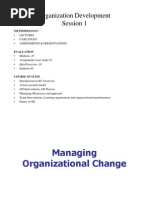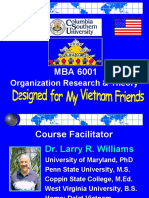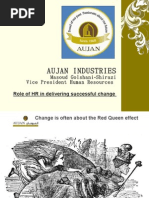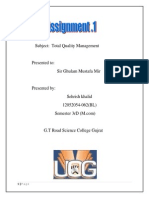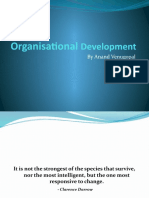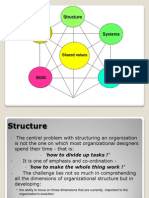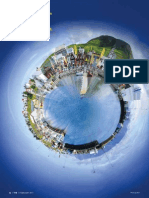Measuring and Managing
Measuring and Managing
Uploaded by
doremi78Copyright:
Available Formats
Measuring and Managing
Measuring and Managing
Uploaded by
doremi78Original Description:
Copyright
Available Formats
Share this document
Did you find this document useful?
Is this content inappropriate?
Copyright:
Available Formats
Measuring and Managing
Measuring and Managing
Uploaded by
doremi78Copyright:
Available Formats
Measuring and Managing
High Performance Culture
Transformation
Presented by:
Rohn Rajen
Partner
Human Capital Group Asia Ltd
Measuring and Managing
High Performance Culture Transformation
Basic questions:
What is a high performance culture?
Is performance linked to organizational culture?
Can culture be measured?
How to change culture?
Good example? Case study
High Performance Culture
The Denison Model
What is Culture?
Deeply held beliefs and assumptions
How people in our organization think and act,
every day
the way things are done around here
Result
Beliefs &
Assumptions
Mind
set
Behavior
Performance
Dr Denison, IMD
History
Model developed by Prof. Daniel Denison
of IMD
Based on over 25 years of research linking
organizational culture and leadership to
performance measures such as
Return on Equity (ROE)
customer satisfaction
sales growth
employee satisfaction
innovation
quality and other performance measures
Solutions
Mergers & Acquisitions
Transformation & Turnaround
Aligning Strategy & Human Capital
Talent Management & Leadership
Development
Leadership Transitions
Services
Denison Organizational Culture Survey
Modules: Engagement, Innovation, Trust
Denison Leadership Development Survey
Change Monitors
Pulse surveys build in accountability and check
points
On-line Dashboard and Action Planner
Helps organizations translate survey results
into actionable interventions
Research & Consulting Group Services
Custom questions and reports development
Qualitative analysis
Change management
1086 companies in 48 Countries, >500,000
respondents
75% North American, 15% Europe, 7% Asian,
3% Africa/Middle East/Central & South
America
Different Industries and different Countries, on
average, have very similar results to the
global benchmark
Using the Global Benchmark database
Composites are available for many different
Industries and Countries
Global Benchmark
Organizational Interventions
HIGH PERFORMANCE ORGANIZATIONS
1
2
Adaptability
Pattern..Trends..
Market
Are we listening
to the marketplace?
Mission
Direction..
Purpose..
Blueprint
Do we know where
we are going?
Involvement
Commitment ..
Ownership
Responsibility
Are our people
aligned and engaged?
Consistency
Systems..
Structures..
Processes
Does our system
create leverage?
This is one of
the four key
traits that
impact
business
performance.
This is one of the
three indices that
measure behaviors
for this trait. Each
of the twelve indices
consists of five
survey items.
This is a percentile
score. A
percentile is
organizations
score as
benchmarked
against the
average of other
organizations. This
organization, for
example, scored
better than 68
percent of all of
the companies in
the database in
the area of Goals
and Objectives.
The profile is colored
to show the quartile
in which the
percentile falls. This
score, for example,
falls in the third
quartile.
More Color
is Better!
A profile of a
high
performing
culture
A profile of an
average
performing
culture
A profile of a
low
performing
culture
12
The Link to Performance
Culture Links to Performance
Innovation &
Customer
Satisfaction
Stable
Performance
Over Time
Profitability
ROI, ROE
Operating
Performance
Quality
Employee Satisfaction
Growth
Flexible and Stable
Flexible
Adaptability + Involvement
A flexible organization has the
capability to change in response to the
environment
Stable
Mission + Consistency
A stable orientation contributes to an
organizations capability to remain
focused and predictable over time
External Focus and Internal Focus
External Focus:
Adaptability + Mission
The organizations focus is
on adapting and changing in
response to the external
environment
Internal Focus:
Involvement + Consistency
The organizations focus is
on the dynamics of the
internal integration of
systems, structures, and
processes
Dynamic Tension:
High performance
organizations learn how to
link the purpose, direction,
and goals of the organization
(top - down) to a shared
sense of responsibility,
ownership and commitment
with all employees
(bottom - up).
Employees understand the
relationship between their
individual goals and the
organizations goals and are
highly motivated to
contribute.
Dynamic
Tension:
Successful
organizations learn
how to cope with the
dual problems of
external adaptation
(stimulate progress)
and internal
integration (preserve
the core).
It is not an either/or
proposition - high
performance
organizations must be
able to do both at the
same time.
Study of Automotive Service Centers in the USA
Total of 338 dealerships and over 12,000 employees
Compares organizational culture and customer satisfaction
Satisfying Your Customers
Below 50% Highly Satisfied Above 80% Highly Satisfied
Impact on Performance
Return-on-Assets 4.5%
Sales Growth .1%
Market-to-Book Ratio 3.5
Return-on-Assets 6.3%
Sales Growth 15.1%
Market-to-Book Ratio 4.4
If we compare the 102 firms in the top and bottom 25% based on their overall
average of the 12 indexes, companies with higher culture scores have greater
profitability, sales growth, and market value than those with lower culture scores.
Top 25% Bottom 25%
Automotive Company
21
2004 2006
Changes in Automotive Company
22
2002 2003-006
Profit On plan 03-05 : Beat profit plan
06: NA Restructuring
Quality 37 PPM Single Digit PPM
New business wins 2 Non GM wins in
prior 5 years
Over 20 non GM wins
Globalization No Asia presence 4 programs won in Asia
New plant established in
China
Global leadership 8 leaders in 5
years
1 leader
Global coordination None Extensive global
coordination
Source : IMD-4-0309 ; 2009
We have the same ingredients and
use the same ovens, but its the
skills, attitude and experience of the
workforce that differentiates the
brands.
David Brandon
Chairman and Chief Executive of Dominos Pizza
T0
PROTON CASE STUDY
CHANGE MANAGEMENT PROJECT (PCMP)
(PROCESS SAMPLE ONLY, DATA NOT INCLUDED)
Initiative T0: Change Management
What the
initiative is
about?
Why is it
important?
What should
change?
How will
success look
like?
What we
need from the
team?
This initiative aims to transform the mindset and working behaviour of all
PROTON employees across the business chain, in tandem with T1 T13 process
and operational excellence initiatives. Ultimately, aligning the companys culture,
values, people and robust processes, to create a high performing organisation.
Working attitude
Communication channel
Legacy issue
Process Change Management requires Behavioral Change Management to
complement it. It is imperative that PROTON as an organisation to embrace both
changes which eventually will result in a more agile, responsive, cohesive hence
productive working culture
Clearly understand Proton imperatives and the need to change
Focus more on the future and less on the past; focus more on finding solutions and
less on lamenting on problems
Willingness and an unwavering commitment to change and be a part of a new
Proton that will be the model for Malaysias global ambitions
We will attain an organisation receptive and resilient to changes for sake of
betterment
We will forge a cohesive organisation which will strive and motivated for a
common goal
We will possess a high performing work culture practising the best-in-class work
processes
Conduct
organisational
effectiveness
and leadership
survey
Collate
and
interpret
results
of survey
Create &
communicate
a coherent
vision, and
empower
team to
execute
Wave 1
Wave 2
and
beyond
Change Management Framework
Climate survey
360 degree survey
Leadership survey
Dennison survey
Engagement survey
A B C
D
E
K
e
y
a
c
t
i
v
i
t
i
e
s
I
s
s
u
e
T
i
m
e
-
l
i
n
e
High
perform-
ing
organisa-
tion
Start Change Deploy Change
12 months 42 ~ 48 months
Not 100%
participation
Tabling results to MD
and senior
management team
Accuracy of results
Results are not readily
accessible
Create a change
vision
Appointment of
Champion and
Program Manager
Appointment of
external expert
Champions are
ineffective
Delay appointment of
external expert
Ensure that quick
wins can be achieved
to anchor sense of
achievement and
credibility
Average 70%
participation
No follow-up
activitiies
Institutionalize new
working culture
Build a monitoring
process to track
change
TBD
Implement & monitor change
6 months
High Performance Leaders
High Performance Teams
High Performance Individuals
Strategic Alignment
High Performance Organization
Denison Survey Results
PMO & Online Dashboard
Action Planning
Transformation Framework
Paving the journey of cultural transformation
Adaptability: Line Item Analysis
Perceived Strengths: Process flexibility; focus on continual
learning and improvement
The perception is
that we
continually
attempt to learn
and improve.
However, attempts
to make changes
are usually met
with resistance. It
is not always clear
how the interests
of the customer
are reflected in
our decisions. We
are generally
reactive when
dealing with
customer concerns
28
Mission: Line Item Analysis
Perceived Strengths: Shared vision and strategic intent
We have a
clear shared
vision and we
are in a
position to
make decisions
that can affect
the industry.
However there
is a tendency
to engage in
short term
thinking. This
often leads to
insufficient buy
in among
employees in
achieving
business
strategies
29
HPL High Performance Leaders
HPT High Performance Teams
HPI High Performance I ndividuals
Leaders Change leader
Middle Manager Change agent
Self directed individuals Empowered shared
leadership
Company wide score board and announcements, with
Online dashboard real time, accessible to all
Quarterly review meeting with PMO, Trainers,
Consultants, MCM, Change agents & Project team heads
Rewards incentives, celebration, recognition and award
ceremonies every month (celebrating success)
Special workshops on Execution Skills for selected
team leaders
HR to look into talent development, PMS, Recruitment
policies on performance, Incentives, Career
development and World class human capability
development.
Dismantle silo structure
Move away from territorial
behavior / attitude
Enhance sense of urgency
and boost momentum to
succeed
Up to
10,00
0
emplo
yees
invol
ved in
transf
Target
2010 2011 2012 2013 2014
Across all 10,000 employees involved in
transformation process by end of 2014
Transformation essence
Core Value Enhancement
Drive by Champions
Program Turun Padang
Yearly Denison
Survey
Leadership Alignment
& Development
SDI Profiling
EQ and Constructive Confrontation
Leadership coaching
Katzenbach Team
Internal Communication
Dashboard Measurement
1
2
3
4
5
6
7
1. Quality
2. Customer
Focus
3. Innovation
4. Teamwork
5. Speed
6. Caring
7. Honesty
8
Quarterly Review
T1
T2
T3
T4
T5
T6
T7
T8
T9
T1
0
T1
1
T1
2
T1
3
Change Starts With Me (3,000 pax) Change Starts With Me (10,000 pax)
P
r
o
t
o
n
s
K
P
I
s
Change Management Long Term Strategy: Wave 1 & Wave 2
Bigger Picture - Measurement & Tracking
(Projected Change in terms of %)
2010 2011 2012 2013 2014
Status Quo
Projected
YoY +5%
Projected
YoY +10%
Projected
YoY +25%
Projected YoY
+40%
High
Performance
Culture
Measurable,
Sustainable,
Manageable
Performance linked
Culture
Measuring and Managing
High Performance Culture
Transformation
Rohn Rajen
rohn@humancapitalgroup.asia
www.humancapitalgroup.asia
Thank you
Q & A
1) CEO as the number one CCO (Chief Change Officer) leading the
whole program
2) Top buy in by all top mgmt members. Only 3 options acceptable;
a) fully support
b) need more information, but supportive
c) doesnt support and willing to leave on my own (not speaking
up, not supporting or sabotaging are not acceptable at all)
3)Corporate philosophy of purpose, vision, direction is clear
4)Culture is measured (Denison) and all initiatives are measurable
5)Communication and open sharing to all (building trust and
buying in)
6)Teach, coach and develop change leader in all levels to build
trust (not trustworthiness/ loyalty)
7)Personal responsibility from everyone (leaders, teams,
individuals, partners)
You might also like
- Summary: Executing Your Strategy: Review and Analysis of Morgan, Levitt and Malek's BookFrom EverandSummary: Executing Your Strategy: Review and Analysis of Morgan, Levitt and Malek's BookNo ratings yet
- Toyota Organization Change ManagementDocument7 pagesToyota Organization Change Managementdoremi78No ratings yet
- EsteeLauder PDFDocument20 pagesEsteeLauder PDFdoremi78No ratings yet
- Change ManagementDocument9 pagesChange ManagementManish SinghNo ratings yet
- CMI White Paper, Change Agility - Feb 2012 - 1 Resultados Change MaturityDocument20 pagesCMI White Paper, Change Agility - Feb 2012 - 1 Resultados Change MaturityYuri Andres Narvaez MoralesNo ratings yet
- Chapter 14 Notes PDFDocument8 pagesChapter 14 Notes PDFIrish MagbanuaNo ratings yet
- Transformation and Levels of Work - CRF BreakfastDocument8 pagesTransformation and Levels of Work - CRF BreakfastStanley ArumugamNo ratings yet
- Organizational Climate: (Type The Document Subtitle)Document4 pagesOrganizational Climate: (Type The Document Subtitle)rrjannatNo ratings yet
- Human Aspects of Strategy ImplementationDocument48 pagesHuman Aspects of Strategy ImplementationDiksha Sinha100% (5)
- Understanding Business Excellence PDFDocument20 pagesUnderstanding Business Excellence PDFhunterboyrajNo ratings yet
- OD Chapter 1Document28 pagesOD Chapter 1Hazel GasconNo ratings yet
- LeadershipDocument32 pagesLeadershipmaimoona22No ratings yet
- Organization Development Session 1: MethodologyDocument24 pagesOrganization Development Session 1: Methodologydevisoumyaja272No ratings yet
- HR AssignmentDocument26 pagesHR AssignmentGihan Lakshan GunaratneNo ratings yet
- Total Quality Management TQM Case StudyDocument5 pagesTotal Quality Management TQM Case StudyDilip KumarNo ratings yet
- OB11 ChangeDocument35 pagesOB11 ChangejithinrajssecNo ratings yet
- VN - MBA 6001 - Org Research & TheoryDocument88 pagesVN - MBA 6001 - Org Research & TheorychephuonganhNo ratings yet
- Assignment Operation Management Rev 1Document19 pagesAssignment Operation Management Rev 1saiful bahariNo ratings yet
- Human Resource ManagementDocument22 pagesHuman Resource ManagementAbrar Ul HaqNo ratings yet
- Leadership Workshop Ver1Document33 pagesLeadership Workshop Ver1Anonymous iMq2HDvVqNo ratings yet
- OD & Global Supply ChainNOVDocument41 pagesOD & Global Supply ChainNOVDragos MacoveiNo ratings yet
- Organisation DevelopmentDocument14 pagesOrganisation DevelopmentDaliya ManuelNo ratings yet
- The Missing Link - Connecting Organizational and Financial PerformanceDocument14 pagesThe Missing Link - Connecting Organizational and Financial PerformanceEricV123No ratings yet
- ConclusionDocument2 pagesConclusionFeker H. MariamNo ratings yet
- Quality Toolkit Unit-4Document16 pagesQuality Toolkit Unit-4Mrs.Mriga JainNo ratings yet
- Dynamic Management PhilosophyDocument22 pagesDynamic Management PhilosophyVarma DantuluriNo ratings yet
- How To Use The Tool: Step One: Analyze Each Key Element SeparatelyDocument9 pagesHow To Use The Tool: Step One: Analyze Each Key Element SeparatelySasha KingNo ratings yet
- OGL 357, Milestone 3Document4 pagesOGL 357, Milestone 3courtney schollmeyerNo ratings yet
- Change Management: "We Must Pledge Once More To Walk Into The Future."Document53 pagesChange Management: "We Must Pledge Once More To Walk Into The Future."ShivanshKatochNo ratings yet
- OD Week 3Document53 pagesOD Week 3Hazel GasconNo ratings yet
- Org DevelopmentDocument16 pagesOrg DevelopmentG of W & WNo ratings yet
- Role of HR in Delivering Successful ChangeDocument24 pagesRole of HR in Delivering Successful ChangeMasoud Golshani ShiraziNo ratings yet
- Organizational Change: Why Should We Study It?Document25 pagesOrganizational Change: Why Should We Study It?9986212378No ratings yet
- Case StudyDocument3 pagesCase StudymehaNo ratings yet
- Quality Statement of Banking SectorDocument5 pagesQuality Statement of Banking SectorSana JavaidNo ratings yet
- Hands Out COyL I - Part 2Document5 pagesHands Out COyL I - Part 2MAFERNo ratings yet
- Analysis of Organizational Development Tata Consultancy ServicesDocument6 pagesAnalysis of Organizational Development Tata Consultancy ServicesaaasshhiimmaaNo ratings yet
- Organizational DevelopmentDocument16 pagesOrganizational DevelopmentG of W & WNo ratings yet
- Wazir Ahmad PM Week 2 PDFDocument5 pagesWazir Ahmad PM Week 2 PDFWazeeer AhmadNo ratings yet
- OD IntroDocument16 pagesOD IntroRameshwari WadghuleNo ratings yet
- What Is Organisation Change Management?: Focus OutcomeDocument17 pagesWhat Is Organisation Change Management?: Focus Outcomesabah21No ratings yet
- SBM Chapter - 02Document28 pagesSBM Chapter - 02Naoman ChNo ratings yet
- Leadership - Three OpEx Questions You Need To Know The Answers ToDocument26 pagesLeadership - Three OpEx Questions You Need To Know The Answers Tomilou88No ratings yet
- McKinsey 7S ModelDocument5 pagesMcKinsey 7S Modelhakunamatata6088No ratings yet
- Chapter 8Document24 pagesChapter 8ekraange73100% (1)
- Quality Element Previous State TQMDocument3 pagesQuality Element Previous State TQMArdalan_mar2001No ratings yet
- Building Winning Organisations: A complete guide to sustaining best-in-class performance for all organisationsFrom EverandBuilding Winning Organisations: A complete guide to sustaining best-in-class performance for all organisationsNo ratings yet
- Ion DevelopmentDocument41 pagesIon DevelopmentAnand VenugopalNo ratings yet
- Change Management 1Document50 pagesChange Management 1rocknroll_mahive1789No ratings yet
- Structure: Shared ValuesDocument12 pagesStructure: Shared ValuesPrem TiwariNo ratings yet
- ODDocument18 pagesODMeenakshi GodaraNo ratings yet
- Cbmec FinalsDocument18 pagesCbmec FinalsShiella marie VillaNo ratings yet
- Group10 Appex Final FinalDocument25 pagesGroup10 Appex Final FinalAnjan Kumar Dash100% (3)
- LeadershipDocument5 pagesLeadershipm.shehrooz23No ratings yet
- 3and4-Core Values and BEDocument12 pages3and4-Core Values and BEAnju SavithriNo ratings yet
- Module II Lec4Document6 pagesModule II Lec4Kumar KrisshNo ratings yet
- Fred R. David Prentice-Hall, Inc. Sixth EditionDocument26 pagesFred R. David Prentice-Hall, Inc. Sixth EditionUdaya Kumar.pNo ratings yet
- The Journey: Achieving Sustained Organizational SuccessFrom EverandThe Journey: Achieving Sustained Organizational SuccessNo ratings yet
- Purpose, Productivity, and Profit through Project ManagementFrom EverandPurpose, Productivity, and Profit through Project ManagementNo ratings yet
- Strategic Management ReportDocument25 pagesStrategic Management Reportdoremi780% (1)
- MHM1523-Ind Assignment-Estee Lauder Companies, Inc-Wong Yean Chong-1Document26 pagesMHM1523-Ind Assignment-Estee Lauder Companies, Inc-Wong Yean Chong-1wisely100% (1)
- Training & DevelopmentDocument21 pagesTraining & Developmentdoremi7883% (6)
- Using Online Tools To Engage The Public 0Document41 pagesUsing Online Tools To Engage The Public 0Neelesh SajnaniNo ratings yet
- Change Management: Chris Colomb Trish Fullmer Jordan Bloodworth Veronica BeichnerDocument20 pagesChange Management: Chris Colomb Trish Fullmer Jordan Bloodworth Veronica Beichnerdoremi78100% (1)
- Malaysian Economics Development PDFDocument171 pagesMalaysian Economics Development PDFtheatresonicNo ratings yet
- Measuring and ManagingDocument37 pagesMeasuring and Managingdoremi78No ratings yet
- Managing Government Property AssetsDocument18 pagesManaging Government Property Assetsdoremi78No ratings yet
- TrainingandDevelopment FebDocument8 pagesTrainingandDevelopment Febdoremi78No ratings yet
- Critical Thinking Individual Assignment: Pramnath A/L ShanmugamDocument4 pagesCritical Thinking Individual Assignment: Pramnath A/L Shanmugamdoremi78No ratings yet
- Event Study AnalysisDocument43 pagesEvent Study Analysisdoremi78No ratings yet
- CaseStudy Maeurer Wirtz enDocument4 pagesCaseStudy Maeurer Wirtz endoremi78No ratings yet
- Cultural Spheres of Influences STD 11Document14 pagesCultural Spheres of Influences STD 11doremi78No ratings yet
- ts72 - 05 - Alshalabi - Etal - 0702 PDFDocument17 pagests72 - 05 - Alshalabi - Etal - 0702 PDFdoremi78No ratings yet
- Sephora Case StudyDocument12 pagesSephora Case StudyhugorojasespinozaNo ratings yet












